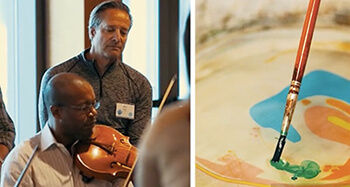
Your increasingly common talent problems are only growing more “wicked” every year. Challenges such as, how do we:
- Attract young talent to our industry, which is decidedly “unsexy”?
- Do effective succession planning for a uniquely skilled leader or expert?
- Reskill employees whose jobs are being dramatically changed by new technologies?
- Motivate veteran employees with deep expertise to share critical knowledge with successors?
- Recruit and retain women and minorities into traditionally male fields?
These problems are not going to be solved with traditional strategies. They demand more creativity, innovation and enhanced collaboration from a wide variety of stakeholders. That’s the approach taken by Harvey Seifter and his colleagues at the Art of Science Learning.
Check out this video for more about Seifter’s work, which uses the arts (e.g., music, painting, sculpture, & theater) to enhance innovation and collaboration to solve particularly tough problems.
Here are three things Seifter’s research, funded by the National Science Foundation, has taught him that will be relevant to solving “wicked” workforce problems.
1. Ready, Fire, Aim” is a no way to grow talent.
In the rush of everyday work life, we more often than not jump to problem solving before we’ve identified and defined the problem with clarity, says Seifter. This default impulse can frequently lead to the wrong answers in workforce problems because leaders are addressing the wrong questions. And then wasting more time and resources recovering from their misguided approach.
Seifter’s research has shown that we get more innovative outcomes and a better return on our time and resources when we start with a couple of baseline questions before jumping into problem-solving mode:
- Why is that the real problem? What is our real objective?
- Why is the condition we’re responding to the way it is?
These questions may sound simple, but by repeatedly forcing ourselves to answer them, we go deeper and, through iteration, reach the point where we’re defining workforce problems in a way that will lead to impactful – as well as innovative – solutions.
2. Effective collaboration is a key to successful workforce innovations.
Through innovation incubators in San Diego, Chicago, and Worcester, Mass., Seifter’s team has demonstrated that collaboration is central to sparking and sustaining innovation. And the best way to get good at collaboration is through practice. The U.S. Chamber of Commerce Foundation is now actively promoting collaboration as an approach to solving critical skill shortages. The Chamber’s Talent Pipeline Management Academy is built on the idea of creating effective employer collaboratives to address specific workforce challenges for a region or industry sector.
The dozens of multi-employer collaboratives spawned by the Chamber’s training program have proved to be a great laboratory for demonstrating the benefits of building trust and mutual respect. Participating employers increasingly experience collaboration as the key to innovative and sustainable workforce solutions.
3. Discover new ways of conceptualizing old problems.
Seifter’s field research related to innovation has also shown that people often don’t take in information that’s right in front of their noses. This is especially true when time pressures lead us to seek short-cuts to problem solving, even when we risk missing key data.
With particularly threatening talent issues, such as the retirement of a critical expert or a total lack of qualified job candidates, we tend to instinctively shy away from disruptive information. This is true even when what’s most provocative may ultimately prove most productive. Here are a few simple activities that will take you out of your comfort zone, but can yield surprising results. Strengthening your observational skills can help you shed old habits of looking at workforce problems the same way:
- Take a walk in nature, pick up things along the trail and spend a few minutes really looking at them. What surprises you?
- Bring one of the objects home with you and spend a few minutes carefully sketching it. Don’t worry about the “artistic content of your drawing”. Just draw what you see. What new information emerges?
- Take a photo of an object from different angles. Take out a piece of paper and pencil and draw a single integrated image that best represents all the angles. What did you learn about observation from this exercise?
Ask yourself, how can I apply what I’ve learned from these exercises to how I’m looking at this seemingly unsolvable talent problem.
Albert Einstein said, “The problems that exist in the world today can’t be solved by the level of thinking that created them.” The workforce challenges we face today won’t be fixed with traditional, siloed, top-down approaches that might have worked in the past.
To break out of the pack, you need much more creative ways to define the real talent challenges you face and to design and implement innovative, high-impact solutions. Bringing new artistic perspectives to the table could be essential to making real progress on these seemingly intractable problems.
